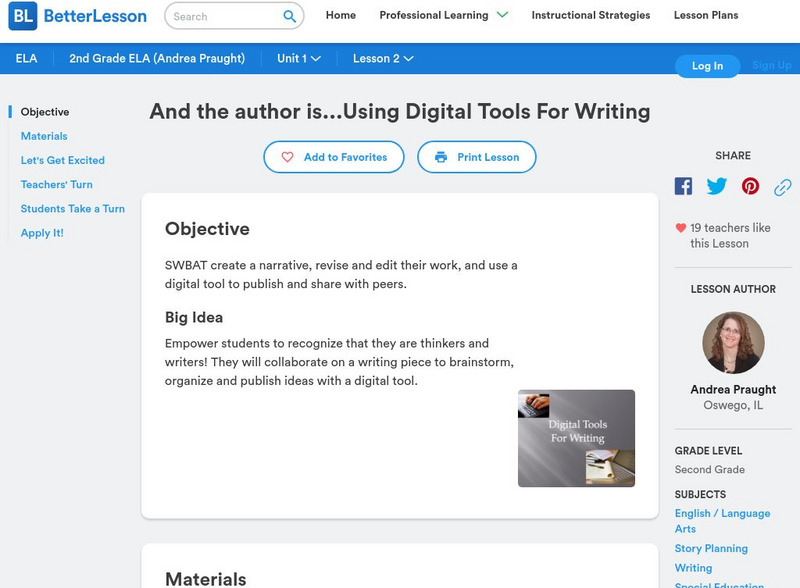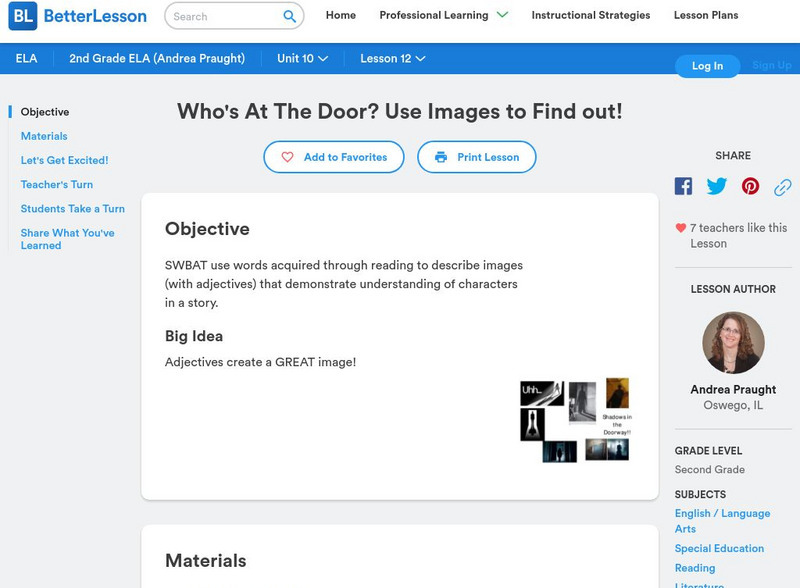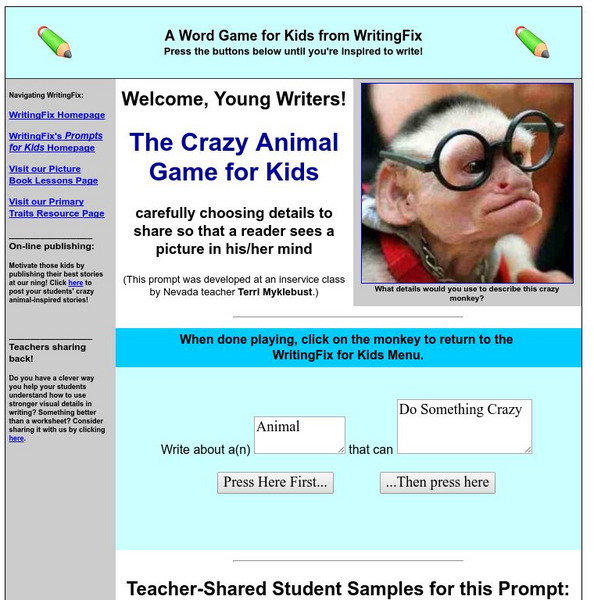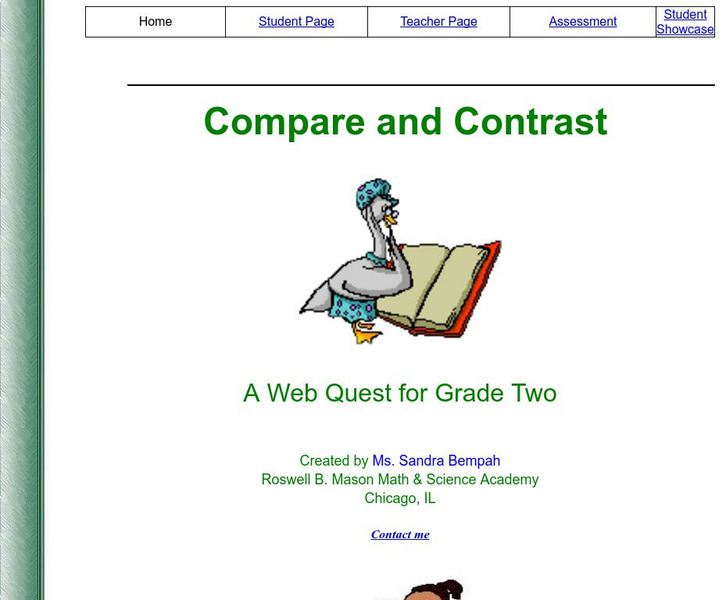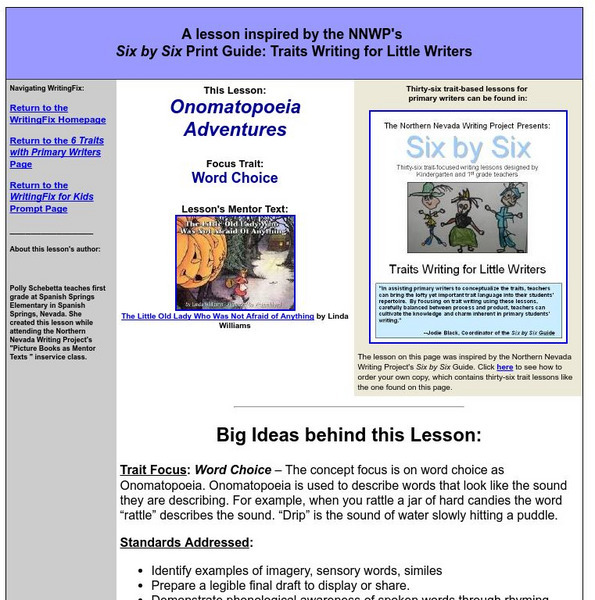CPALMS
Cpalms: The Magical Library
In this tutorial, students will take a virtual trip to a library and learn how to identify the genre, author, and illustrator of a book. After listening to short segments from a magical wizard, students will identify books that are story...
Better Lesson
Better Lesson: Go, Dog, Go!
Students will read the story and describe the picture details of the illustrations in relation to the text and write about one of the story events. "Go, Dog, Go!" contains illustrations that are very elaborate and crazy while the text is...
Better Lesson
Better Lesson: Describing a Memory
Students will be able to use a combination of drawing, dictating, or writing to narrate a single event and provide a reaction to what happened. This lesson centers around the book "The Song and Dance Man", a great Grandparents Day activity!
CPALMS
Cpalms: What Do You Do With a Tail Like This?
[Free Registration/Login Required] In this instructional activity, students will use What Do You Do With A Tail Like This? by Steve Jenkins and Robin Page to identify the main topic and key details using the illustrations and text....
Read Works
Read Works: Lesson 1: Actions
In this resource, students will practice identifying and describing the actions of a character. Teachers will model these skills through the use of text and pictures from the story No, David! by David Shannon. Students will then draw a...
Better Lesson
Better Lesson: And the Author Is...using Digital Tools for Writing
Empower students to recognize that they are thinkers and writers! They will collaborate on a writing piece to brainstorm, organize and publish ideas with a digital tool. This lesson highlights different website creations as examples of...
Better Lesson
Better Lesson: Tie It Up With Transition Words to Write a Story!
Read, write, and present a digital narrative with transition words to help us put the events in order! After modeling the lesson, groups of students will write narratives to recount a short sequence of events, they will include details...
Better Lesson
Better Lesson: Who's at the Door? Use Images to Find Out!
Young scholars will use words acquired through reading to describe images (with adjectives) that demonstrate an understanding of characters in a story. The teacher will read Miss Nelson is Back which has great descriptors and will hold a...
CPALMS
Cpalms: Wild About Authors and Illustrators
[Free Registration/Login Required] In this lesson, students learn about the roles of authors and illustrators through games and book-writing. Students will have an opportunity to act out the roles of illustrators and authors. They will...
Writing Fix
Writing Fix: The Crazy Animal Game for Kids
Students use this writing topic generator to choose an animal and a crazy action the animal is able to do in order to give them something fun and creative to write about.
Writing Fix
Writing Fix: All About Posters
As young writers become more skilled through the Writers Workshop lessons, they can begin working to become more skilled with non-fiction writing. A series of mini-lessons, graphic organizers, and samples of student work are all provided.
Writing Fix
Writing Fix: Borrowing From Books
Six mini-lessons teach young writers how to borrow ideas or patterns from popular children's books to use in their Writing Workshop pieces. Text ideas and student samples are provided.
Writing Fix
Writing Fix: Write About Something Real at School
In this Writers Workshop lesson, students look around themselves and think about their daily lives at school to find relevant writing topics.
Writing Fix
Writing Fix: A Small Moment With an Important Person
A writer's workshop idea where students brainstorm a list of people who are important to them as well as one or two times they remember being with each person. Students then use these ideas to write about a small moment with someone who...
E Reading Worksheets
E Reading Worksheets: Setting Worksheets
In this learning module, students will study the concept of setting in literary text. Worksheets and PowerPoint lessons are provided to help students practice with finding "settings" and then citing reasons that support their answers.
Curated OER
Mc Graw Hill: Key Ideas and Details: Retell Stories
Read a passage to discover how to retell a story then practice what you've learned.
Curated OER
Mc Graw Hill: Major Events
Learn how writers use details to describe major events in a story.
Curated OER
Mc Graw Hill: Part 1: Reading Literature: Use Illustrations and Details
Learn how drawing characters, settings, and events can help with reading comprehension.
Curated OER
Mc Graw Hill: Compare Characters' Point of View
Defines and explains how to show how different characters think and feel.
Other
Castle Technology: Compare and Contrast: A Web Quest for Grade Two
This activity for young readers includes step-by-step teacher directions, student directions, resources, and rubrics. Students read or listen to two or more versions of a fairy tale and then work in groups to update the fairy tale to a...
Other
Literature Lesson Plan
This lesson plan is for a character study that uses butcher paper, pens, pencils, and copies of assigned book. Students then complete a character study on at least two major characters.
Other
Laus Dnet: Grade 1 Word Lesson Plan (Stone Soup) Pdf
In this lesson plan, students use Stone Soup by Ann McGovern to generate word lists and use patterned text to assist with descriptive writing. Gives links to step sheets and samples for creating a table , a template for shared writing, a...
Quia
Quia: Literary Terms Quiz
In this self-scoring practice activity, students read four passages and select the main idea of each.
Writing Fix
Writing Fix: Onomatopoeia Adventures
In this lesson plan, The Little Old Lady Who Was Not Afraid of Anything, by Linda Williams, is used as a mentor text to highlight the trait of word choice. Onamatopoeia is the focus content for this activity. After the reading of the...







